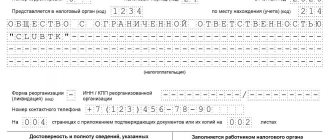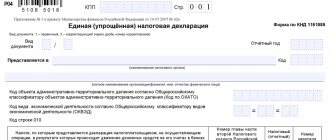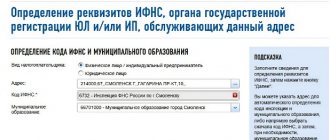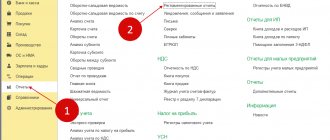How to file a zero tax return
A zero 3-NDFL report is submitted according to the general rules, but with zero indicator values.
It should be submitted even if you did not conduct business this year. Article navigation
- Who must submit a zero declaration and when?
- Composition of zero reporting documents
- Features of a zero declaration under the simplified tax system
- Zero reporting for OSNO
- Filling out a zero VAT return
- Zero declaration of individual entrepreneurs for personal income tax
- Composition of a zero declaration for UTII
- conclusions
All individual entrepreneurs and companies are required to report profits received and taxes paid. The final document is the tax return. If the taxpayer did not conduct commercial activities and there was no movement of funds in his accounts, he submits a zero declaration.
Reporting form
Note! In 2021, a new form of the simplified tax system declaration was approved, but the report for 2020 is still submitted using the old form. The new form is relevant for individual entrepreneurs and LLCs that closed in 2021 and file a declaration after March 20, 2021.
The form of the annual declaration under the simplified tax system for 2021 was approved by order of the Federal Tax Service of Russia dated February 26, 2016 No. ММВ-7-3/ [email protected] and is valid for reporting for the periods from 2015 to March 20, 2021.
If an individual entrepreneur’s zero reporting is submitted using an outdated form, it is considered not submitted. Of course, if you personally submit the report to the inspectorate, they will tell you that the form does not match, but if you sent the declaration by mail, you will assume that it was submitted, although this is not the case.
Before you fill out a zero declaration under the simplified tax system, please note that different tax objects (Income and Income minus expenses) have their own sheets. You only need to fill them out, not the entire form.
| USN Income | USN Income minus expenses |
| Title page | Title page |
| Section 1.1 | Section 1.2 |
| Section 2.1.1 | Section 2.2 |
| Section 2.1.2 (only for those who are registered as a trade tax payer) |
In addition, regardless of the simplified version, entrepreneurs who have received targeted funding fill out section 3.
Who must submit a zero declaration and when?
Entrepreneurs believe that they are not required to report if there are no taxes to pay. But that's not true. Reporting must be provided regardless of whether the activity occurred or not.
By registering a business, a citizen becomes a taxpayer, and the amount of charges is determined based on reports submitted to the relevant services. If the document is not submitted, this does not mean that taxes are canceled. The inspectorate simply cannot determine the amount of deductions and punishes the entrepreneur for violating the law.
In cases where the activity of an enterprise is suspended or not carried out for various reasons, it is necessary to submit a zero declaration. It confirms the fact that there is no profit and that there are no taxes payable. The declaration must be accompanied by a free-form explanation indicating the reasons for the lack of payments.
Filing a zero return is provided for the following taxes:
- VAT – on added value;
- Personal income tax - on the income of an individual, but only if the individual entrepreneur works for OSNO;
- Unified Agricultural Tax (USA) (the first year after state registration);
- for individual entrepreneurs using a simplified taxation system;
- on the profits of organizations.
For all other taxes, you do not need to file a zero return. In the event that the tax base of an entrepreneur, after applying various benefits, turns out to be negligible, the reporting is no longer zero, and he needs to fill out regular tax returns.
A controversial issue is zero reporting on UTII. According to the Tax Code of the Russian Federation, this taxation system does not provide for the submission of a zero declaration, but can be accepted as an exception, for example, in case of temporary loss of ability to work of an individual entrepreneur.
A zero tax report for individual entrepreneurs is submitted if:
- the taxpayer received a state registration certificate, but was not engaged in his activities throughout the entire period before the reporting date;
- economic activity has a pronounced seasonal nature (therefore, during the season of active commercial activity, regular reporting is provided, and in the off-season, when there is no movement of funds in the accounts, it is better to fill out a zero declaration);
- the taxpayer has suspended its activities, but is formally considered an active business entity, having no debts to partners, clients, the state and no movement of funds in its accounts.
A zero return must be submitted to the tax office within the same time frame as reporting with numerical data. The frequency of submission depends on the type of tax chosen by the entrepreneur for conducting business. A zero declaration for an individual entrepreneur working under the simplified tax system is submitted annually before April 30, for a legal entity - until March 31. For VAT and UTII, reporting is submitted quarterly - before the 20th day of the month following the reporting period, for income tax - every quarter until the 28th, for 3-NDFL - once a year until April 30.
Submitting reports to the simplified tax system
As mentioned earlier, the simplified taxation system is the most attractive reporting system. In this case, a zero declaration is submitted, which is also attractive because it is easy to fill out and submit to the tax office. Moreover, it does not matter at all what object of taxation is chosen, the “zero” can be surrendered in any case.
There is one caveat. When choosing the object of taxation “income”, the tax base will be absent, as well as the receipt of profit. If the object is “income minus expenses,” even if a loss occurs, then it is necessary to pay a tax in the amount of 1% of the amount of income.
Thus, a zero declaration of the individual entrepreneur of the simplified tax system can be submitted only under conditions when the company did not operate and there were no income.
Composition of zero reporting documents
A zero declaration is a standard reporting document reflecting the absence of activity. There are no special forms for it. They submit zero declarations on the same forms as reporting indicating significant numerical indicators, but their composition may be different, depending on the selected period and the individual entrepreneur taxation system.
Composition of a zero declaration by type of taxation:
| Reporting period | Composition of the declaration |
| A reporting period with quarterly advance payments or a reporting period with quarterly payments with monthly advances. | Title page, subsection 1.1 in the first section of the document. Data is also entered into sheet 2 and appendices No. 1 and 2. |
| Reporting period with monthly payment of advances on profit received from the actual activity. | Title page, subsection 1.1 of the first section, sheet 2. |
| Annual report. | Title page, subsection 1.1 of the first section, sheet 2 and appendices No. 1 and 2. |
To ensure that all data is entered fully and correctly, you should use a zero declaration form for individual entrepreneurs approved by the Federal Tax Service. Orders of the Federal Tax Service establish both sample declarations and rules for filling them out.
When preparing a document:
- the text must be written in black, blue or purple ink only;
- the data in the declaration must be written in capital block letters (when filling out the document electronically, Courier New font size 16-18 is used);
- there should be no errors, corrections or blots;
- letters and numbers are entered one in each cell, words are separated from each other by an empty cell;
- amounts are indicated only in rubles, that is, without kopecks (rounding is carried out according to the rules of mathematics);
- if the amount is zero, a dash is placed in the cells.
The peculiarity of filling out a zero declaration is that most of the data will be missing. The preparation of the document should begin with the title page. To do this correctly, you can see a sample of filling out a zero declaration, for example, on the website of the State Services service.
In the header of the title page you must indicate the TIN and KPP of the entrepreneur, as well as the serial number of the page. The following is information about:
- tax period;
- code and name of the regional representative office of the Federal Tax Service;
- full name of the enterprise (abbreviation should be indicated in brackets);
- OKVED code, according to which the individual entrepreneur operates;
- total number of pages;
- taxpayer - last name, first name, patronymic.
At the end of the sheet the date of filling out the declaration and the signature of the official are indicated.
In subsection 1.1 of section 1, indicate the TIN, KPP, code according to OKTMO and KBK. All other columns are marked with dashes.
The second sheet of the document contains information about the calculation of tax, but since it cannot exist in the absence of income, only the TIN, KPP, and taxpayer code are indicated.
Additional indicators include tax rates assigned in a specific region. All other fields are filled with dashes.
In the appendices to the second sheet, only three main indicators should be entered - TIN, KPP, taxpayer code. In addition, Appendix No. 2 indicates the method of calculating depreciation for a specific enterprise. All other lines are marked with dashes.
You can make a zero individual entrepreneur report on the simplified tax system, OSNO or personal income tax using the online service “My Business”. The service automatically generates a document, checks it and sends it electronically.
What are the general requirements for filling out a single declaration?
The EUD can be filled out both on paper and electronically. When forming on paper, the following requirements must be observed:
- the EUD form can be filled out on a computer and printed;
- When filling out manually, use a blue or black pen;
- The EUD is filled out in block letters;
- the error is corrected as follows: the incorrect value is crossed out (with one line so that it is clear that it has been crossed out), then the correct value is entered next to it and certified with a signature and seal (if any);
- erasures and puttying are not allowed.
You can fill out the EUD for 2021 on our website:
The EUD has 2 sheets. The first sheet is filled out by everyone submitting this declaration. He contains:
- details of the taxpayer and his Federal Tax Service;
- a tabular part where data on taxes are entered, in exchange for which the EUD is submitted;
- Also in the tabular section you need to enter for each tax the number of the chapter of the Tax Code of the Russian Federation by which this tax is regulated.
IMPORTANT! Only 4 taxes are placed in the table on sheet 1 of the EUD at a time. In a situation where there are suddenly more reported taxes, you need to fill out the second sheet of 1 EUD.
Sheet 2 of the EUD is intended to reflect additional data about an individual - not an individual entrepreneur. Individual entrepreneurs and enterprises do not form it.
Features of a zero declaration under the simplified tax system
Individual entrepreneurs operating under a simplified tax system must report under this regime. Since entrepreneurs do not keep accounting records, they do not submit accounting documentation to the Federal Tax Service. Zero reporting of individual entrepreneurs under the simplified tax system in 2021 includes only sheets of the annual declaration.
There is one more advantage for individual entrepreneurs: unlike organizations, they are not automatically recognized as employers, therefore they are registered as an insurer only after concluding an employment contract with employees. If the entrepreneur did not conduct business and did not enter into such an agreement, then he is not an insurer and does not submit reports for employees.
There is no requirement to submit reports regarding the payment of personal insurance premiums. The entrepreneur is only required to make fixed payments for personal health and pension insurance.
In 2021, contributions for pension insurance amount to 29,354 rubles, and for medical insurance – 6,884 rubles.
If at least some funds passed through the bank accounts of the simplified person or through the cash register, it will not be possible to get away with a zero declaration. It will be necessary to submit a standard report with all indicators.
A zero report to the tax office for individual entrepreneurs must be provided at the place of registration. It can be done:
- by contacting the Federal Tax Service in person or using the services of an authorized representative;
- by registered mail;
- using telecommunication channels.
Submission of zero reporting for individual entrepreneurs to the simplified tax system is carried out once a year, no later than April 30, and for legal entities. persons – until March 31. Failure to timely submit a declaration to the Federal Tax Service may result in penalties. The Federal Tax Service has the right to suspend transactions on bank accounts until the report is submitted.
Strict adherence to deadlines
To avoid such problems, the taxpayer should always know where to look for a new and current sample of the zero declaration, since changes and filing deadlines may periodically appear in it. Individual entrepreneurs submit zero declarations no later than April 30 for the previous year.
This is a very realistic period to prepare all the reports, especially if they are zero. If all filling rules and submission deadlines are followed, the taxpayer will never have problems with the tax authorities.
Zero reporting for OSNO
There are a number of taxes that are mandatory for the general regime - these are income tax and VAT. They will have to submit zero declarations even if there is no cash flow. These documents must include a title page and the required dashed sections.
Entrepreneurs using the general taxation system should submit zero declarations:
- for VAT – quarterly, until the 25th day of the month following the tax period;
- for income tax - every quarter, until the 28th day of the month following the reporting period;
- for property tax - quarterly, until the 30th;
- for insurance premiums - quarterly, until the 20th;
- accounting report – once a year, until March 31 of the following year.
In the absence of economic activity, it is allowed to submit a simplified declaration - EUD, which replaces reports on value added and profit taxes. It must be sent to the Federal Tax Service by the twentieth day after the end of the reporting quarter.
The EUD can be submitted to the tax office:
- in electronic form, using software products designed for sending reports;
- in electronic form using a program from the Federal Tax Service (you will need a registered digital signature);
- on paper during a personal visit to the Federal Tax Service;
- on paper via postal mail (valuable letter with a list of attachments).
All VAT reporting should be submitted only electronically. Those who do not pay VAT can submit zero declarations, both electronically and on paper (at the discretion of the respondent). You can fill out an individual entrepreneur’s zero declaration online in any online accounting program. It’s quite convenient to do this in the “My Business” service.
A single simplified declaration instead of a zero according to the simplified tax system
Instead of a zero declaration under the simplified tax system, you can submit a single simplified tax return (SUD). But for this the following conditions must be met:
- Absence of an object of taxation in the tax period.
The object of taxation under the simplified system is income (for the simplified tax system 6%) or the difference between income and expenses (for the simplified tax system 15%).
- No transactions on the current account.
There should be no transactions at all - not even payment of utilities.
The EUD consists of only one sheet and is submitted to the Federal Tax Service no later than January 20 of the year following the reporting year. That is, the EUD according to the simplified tax system for 2021 must be submitted by 01/20/2020.
The most optimal solution in the absence of activity in the tax period would be to submit a zero declaration under the simplified tax system. Filling it out is no more difficult than filling out a EUD, but the deadline for submitting information is longer and the risk of controversial issues arising is less.
Filling out a zero VAT return
If there are zero indicators of entrepreneurial activity in the declaration, instead of 12 sections, you only need to fill out the title page and the first section.
Filling out the title page:
- TIN – indicates the number issued by the tax service.
- Reporting document adjustment number. If it is submitted for the first time, you should indicate 0. In the case when the declaration has already been submitted for a given reporting period, you must enter 1, 2, etc., depending on what the adjustment is in the account.
- Tax period code. When submitting a report for the first quarter, code 21 is indicated, for the second - 22, for the third - 23, for the fourth - 24.
- Tax authority code. The code of the tax office to which the declaration is submitted is indicated.
- Taxpayer. The full name of the organization is indicated.
- OKVED code.
- Taxpayer's contact telephone number.
- Number of pages.
- Full name of the taxpayer, his signature.
- Date of document creation.
Completing section 1:
- TIN and checkpoint of the organization;
- OKTMO code;
- budget classification code;
- dashes are entered in the cells of all other lines;
- At the end of the document there is a signature and the date of preparation.
Zero accounting statements
The composition of the financial reporting forms is approved by Order of the Ministry of Finance No. 66n. key forms:
- Balance sheet.
- Income statement.
- Cash flow statement.
- Statement of changes in equity.
- Report on the intended use of funds.
- Appendixes to the balance sheet.
An important point: when preparing financial statements, you also cannot leave all balance sheet columns empty. The organization has an authorized capital, possibly funds in an account or in the cash register, and some property. If there are no business transactions during the reporting period, these figures should be reflected in the financial statements.
Zero declaration of individual entrepreneurs for personal income tax
An entrepreneur engaged in business activities individually, that is, without employees, does not submit personal income tax reports. If people work for him, they are paid a salary. In this case, the individual entrepreneur is required to report on forms 2-NDFL and 6-NDFL.
If employees have never been paid a salary in a calendar year, then the entrepreneur is not a tax agent and does not need to submit empty forms.
If an individual entrepreneur did not conduct business for a year and did not receive income, he should submit a zero 3-NDFL. It includes a title page and sections 1, 2. The 3-NDFL zero declaration must be submitted within the same deadline as the standard one - April 30. It can be provided on paper by appearing in person at the Federal Tax Service, sent by mail, as well as using TKS or through the “Taxpayer Personal Account” on the Federal Tax Service website.
The title page is filled out as usual. Section 1 should reflect the following information:
- Full name of the entrepreneur;
- in line 010 you must indicate code “3”, indicating that the individual entrepreneur does not pay or return tax on this declaration;
- line 020 contains the current BCC provided for personal income tax on income received by individual entrepreneurs - 18210102020011000110;
- line 030 indicates the territory code OKTMO according to Classifier OK 033-2013;
- in lines 040 and 050 you need to enter zero values;
- Signature and date are placed at the bottom of the page.
The essence of the document
Any profit in our country is subject to taxation. No citizen who opens his own business has the right to avoid taxes or cancel them. The profit received from the sale of the business is indicated in a document called a tax return.
But reporting is necessary not only for a successful entrepreneur who has made a profit for a certain period, but also for a person who has not received any income during this period.
The entrepreneur must inform the tax authorities that he had no income and has nothing to pay taxes on.
The same should be done if no work was carried out at all during this period . That is, the company was properly registered, but did not begin its activities in the reporting period
In any of these situations, the entrepreneur submits a tax return 3-NDFL in the general form.
As such, there is no special form of zero tax return for individual entrepreneurs . This name is used exclusively at the household level and means that the report indicates zero profit on which tax cannot be paid.
Composition of a zero declaration for UTII
The main difference between the UTII declaration and the others is that the tax is calculated not on the basis of real indicators received for the quarter, but on the basis of such physical indicators as the area of the sales floor, the number of vehicles, etc. This principle of calculating tax payments does not allow Individual entrepreneurs and companies using UTII must report in the absence of activity with declarations with zero indicators.
The taxpayer will not need to submit a UTII return only if he is deregistered with a tax organization. To do this you need to submit an application. The tax authority, having received such an application from the taxpayer, must send him a notice of deregistration. From the moment the notification is received, the entrepreneur loses the obligation to provide a UTII declaration, but in the time before deregistration he will have to report.
Reasons for submitting reports
As mentioned earlier, every year at the end of the tax period, entrepreneurs using the simplified tax system must submit information about their income to the tax office. The main reasons for this may be the absence of any activity for the entire tax period or zero profit figures. There are also reasons for this:
- registration with the tax authority and registration of one’s activities when financial activities have not yet been carried out;
- earning zero profit due to ineffective business management;
- seasonal income generation.
As a result of all this, you need to understand that “zero” can simply save a business from unnecessary checks and give impetus to proper and legal development. All that remains is to understand the procedure for completing the document.








